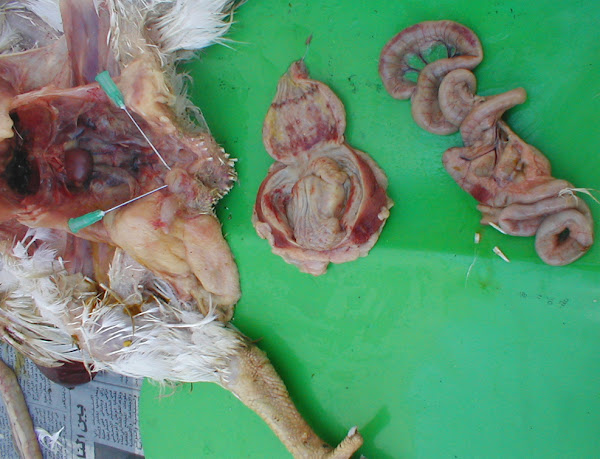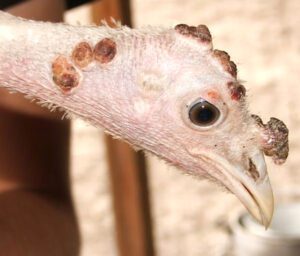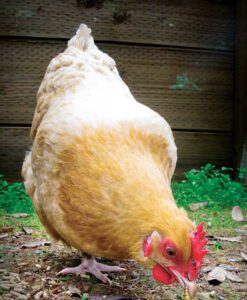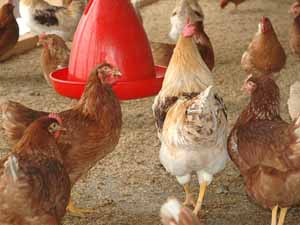Gumboro disease is a highly contagious disease of young chickens and turkeys. It is also known as infectious bursal disease, infectious bursitis and infectious avian nephrosis.
Gumboro disease is caused by infectious bursal disease virus (IBDV), characterized by immunosuppression and mortality generally at 3 to 6 weeks of age.
The Gumboro disease was first discovered in Gumboro, Delaware in the year of 1962. It is economically very important to the poultry industry worldwide due to increased susceptibility to other diseases and negative interference with effective vaccination.
Currently, very virulent strains of IBDV, causing severe mortality in chicken, have emerged in Europe, Latin America, South-East Asia, Africa and the Middle East.
Infection is via the oro-fecal route, with affected bird excreting high levels of the virus for approximately 2 weeks after infection. The disease is easily spread from infected chickens to healthy chickens through food, water, and physical contact.[1]
Gumboro disease damage the working power of all poultry vaccine. As a result the chicken affects by other disease easily. This disease spread from one chicken to another through the used poultry equipment, affected birds food, water, closet etc.
This disease is very harmful for poultry. So, be more careful and take proper care and provide proper treatment.
What is Gumboro Disease?
Gumboro disease, also known as infectious bursal disease (IBD), is a viral infection that affects young chickens and can lead to high mortality rates in infected flocks.
The disease is caused by the infectious bursal disease virus (IBDV), which primarily targets the bursa of Fabricius, an organ located in the chicken’s immune system that plays a key role in the development of B-cells.
The symptoms of Gumboro disease can include depression, loss of appetite, ruffled feathers, and diarrhea. In severe cases, infected chickens may die suddenly without showing any clinical signs of illness.
The virus can be spread through direct contact between infected and susceptible birds, as well as through contaminated feed, water, and equipment.
Preventing Gumboro disease typically involves vaccination of chicks at an early age, as well as practicing good biosecurity measures to minimize the risk of virus transmission.
It is important for poultry producers to work closely with a veterinarian to develop a comprehensive disease prevention and control program.

Causes
Common causes of Gumboro disease are viral transmission, bird age, genetics, stress, contaminated equipment, inproper vaccination, biosecurity measures, climate, poor nutrition, poor management practices, migration of wild birds and lack of quarantine measures.
Symptoms
- Mortality rate of baby chicken is very high.
- Closet of the affected chicken is liquid like water and very unsavory.
- The feather near anus get wet.
- Feathers of the affected chicken get disarranged.
- Affected chicken stop eating.
- They become very thirsty.
- Affected chicken reduces disease preventing power.
- Growing rate of affected broiler chicken get reduced.
- The chicken looses weight.
- Anus of the affected bird become very noisy.
- 30-40 % affected chicken die within 3 day.
- Chicken become very tired, lay down and die due to dehydration.
- Temperature of affected bird become very high and reduce very fast than natural temperature.
- Blood and white mucus flows with closet.
- Baby chicken stay very closer to each other and stay in the corner of poultry house.
Gumboro Disease Defense Method
By following the poultry health guidelines and timely vaccination, the farmer can prevent the gumboro disease. The vaccine of gumboro disease are of two types. One for baby chicken and another for adult chicken.
This poultry vaccines used for baby chicken. Apply the gumboro live vaccine to the chicken within 14-18 days of age. Apply one whit vaccine per eye. This vaccine also can be served the chicken by mixing with water.
Inactivated Vaccine
Gumboro inactivated vaccine used for adult chicken. Use this vaccine 0.3 milliliter per chicken at the age of 18-20 weeks. Apply this vaccine under the skin of chicken using injection.
Remedy
- Provide the affected chicken antibiotic, vitamin and minerals.
- Keep the chicken in healthy and clean place.
- Wash the house and equipment of poultry with formalin and germicide.
- If this disease affect the chicken, call veterinarian as soon as possible.
Treatment and Control
Peri-focal vaccination may not be effective for the combat of an outbreak, due to the rapidity of wild-IBDV spreading.
Passive immunity may protect against challenge with homologous IBDV, as does previous infection with homologous avirulent strains. Breeder flocks may be immunised against IBD so that they would transfer protective antibodies to the progenies, such as broiler and pullet chicks.
Low-attenuated vaccine strains may cause damage to the bursa of Fabricius and immunosuppression in susceptible chicks. Biosecurity with adequate restriction to farm visitation and distancing from other flocks. Post outbreak hygiene measures may not be effective as the virus can survive for long periods in both housing and water.
Hope this guide has helped you. Good luck and may God bless you!






The article was helpful.
Thanks for your honest opinion! Good luck!